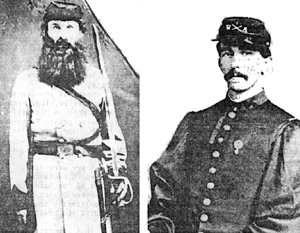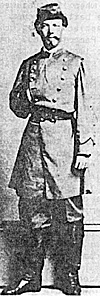 The names have been firmly ingrained in the annals of American Civil War history--Washington Artillery, Louisiana Guard Artillery, Richmond Howitzers, Rockbridge Artillery, Jefferson Artillery, Douglas's Texas Battery, and many, many more. Such units fought with valor but eventually succumbed to superior numbers and a lack of industrial capacity to keep up with the huge cannon factories of the North.
The names have been firmly ingrained in the annals of American Civil War history--Washington Artillery, Louisiana Guard Artillery, Richmond Howitzers, Rockbridge Artillery, Jefferson Artillery, Douglas's Texas Battery, and many, many more. Such units fought with valor but eventually succumbed to superior numbers and a lack of industrial capacity to keep up with the huge cannon factories of the North.
Left: Lt. Edwin H. Guess, Co. B, 9th Georgia Artillery.
Right: Pvt. James W. Price, 3rd Co., Washington Artillery. Note gold pin on chest, which was issued before the unit left New Orleans.
While the Napoleonic Wars were punctuated with whole regiments dissolving under the fire of Grand Batteries, artillery useage in the Civil War became primarily defensive in nature. Specialization became common-place, with the old 6 pounder smoothbores becoming outmoded, being replaced by lighter 12 pounder Napoleons and a whole series of rifled guns. This article does not pretend to be a treatise of ammunition supplies or of the pros and cons of the various gun types. It is intended to give miniature qamers a framework to understand the percentages of the various ordnance used in both of the major Confederate armies. The figures given here, which were compiled from several sources, were used for the artillery tables in my article about adding the "fog of ware to a miniatures engagement.
Strengths and Weaknesses
To understand the differences between the various guns used by the Confederacy, one must first have a rudimentary knowledge of their strong and weak points. The 12 pounder Napoleon turned out to be the favorite artillery piece of the Confederacy. It was lighter, stronger, and gave a more powerful shot than the 6 pound smoothbore gun it replaced. Fairly accurate at medium ranges, it was at its deadliest spewing forth cannister (grapeshot) at point blank range. A drawback, arid probably the only one for the Napol eon, was its lack of accuracy over a distance.
The howitzer, particularly the 12 pound variety, was found in great numbers in the Confederate arsenal at the beginning of the war. However, it was primarily a seige gun and had little effect ir, the wooded terrain so frequently found in ACW battles. It soon fell out of favor, along with the smoothbore, and many were melted down to make Napoleons and a variety of rifled guns.
For long range accuracy, nothing beat the rifled artillery piece. There were a great number of different guns that fell into this category, the most popular being the 3 inch Rodman, 6 inch Rifle, 10 and 20 pound Parrot Rifles, James Rifle, and the Blakely. There were some problems found with most of them, most importantly that the rifled grooves would wear down due to the poor qual ity of metal alloys used, and this would sometimes render the guns useless. A further drawback was the inability to use a rifled gun at close range, since they could not be adapted to grapeshot.
Making guns in the sparse factories of the South proved to be and ever growing problem for the Confederate government. There were shortages of proper metals to cast the guns, factories to make the guns, and even these were slowly falling to the advancing Union forces as the war progressed. This soon led to shortages of new ordnance and left army commanders literally begging for more weapons.
While the artillerists and officers were in general well trained compared to their northern counterparts, problems quickly emerged for the southern long arm. Combined with the shortage of guns was the logistical nightmare of keeping such a variety of pieces supplied with ammunition. It was not uncommon for munitions to arrive only to be met with despair because the shells were of the wrong caliber to be used by the Confederate gunners. Even with these problems, however, many batteries made names for themselves, particularly the Washington Artillery (see photos).
As you will note in the changes of artillery composition listed for both Confederate armies, the Army of Northern Virginia received preferential treatment in receiving new ordnance, much to the chagrin of the. western commanders. At times, older guns from the Army of Tennessee that were sent to be melted and made into Napoleons were, instead, sent to Lee. In both theatres, however, what was received was often too little and too late.
 Capt. Cuthbert H. Slocumb, 5th Co., Washington Artillery (Western theatre)
Capt. Cuthbert H. Slocumb, 5th Co., Washington Artillery (Western theatre)
In examining the artillery of the western theatre, I chose the primary army of the area, the Army of Tennessee, which was formed on November 20, 1862 from a merger of Kirby Smith's Army of Kentucky and Braxton Bragg's Army of Mississippi. In April of 1863 the army's ordnance consisted of the following guns: forty-one 12 lb. howitzers, thirty-five 6 pounders, twenty-one 12 lb. Napoleons, twelve 3 inch rifles, ten 3.8 inch rifles, four 10 lb. Parrot rifles, two 20 lb. Parrot rifles, two 3.3 inch rifles, and two 3.65 inch Wiards, for a total of 129 guns.
There was some improvement seen in November 1863 when there were 46 batteries with 145 guns (not counting horse batteries) listed in ordnance reports. The artillery at that time consisted of forty-eight 12 lb. Napoleons, twenty-eight 12 lb. howitzers, twenty-two 6 pounders, nineteen 3 inch rifles, twelve 10 lb. Parrots, seven James rifles, four 24 lb. howitzers, four 20 lb. Parrots, and one Blakely rifle. Many of the 6 pounders and 12 lb. howitzers had been sent to factories and were made into Napoleons.
Prior to the Atlanta Campaign, the Army of Tennessee, in a report dated April 30, 1864 listed the following field pieces: sixty-four 12 lb. Napoleons, thirty-eight 12 lb. howitzers, ten 10 lb. Parrot rifles, six 3 inch rifles, and two Blakely rifles. Many of the big guns had, by this time, been captured, and others had been rendered useless from wear or bursting. The final figures available are from September 1864, when 124 guns were reported, the army having suffered further losses from the battles around Atlanta. By this time the artillery consisted of mostly Napoleons (90), while the remainder were listed as twenty-two rifles (mostly 10 lb. Parrots and 3 inch rifles), and twelve 12 lb. howitzers. This report was made two months prior to the battles of Franklin and Nashville, where the Army of Tennessee was literally destroyed and ceased to be a factor.
The artillery of the great eastern army, the Army of Northern Virginia, needs to be viewed starting June 1, 1862, the date that Robert E. Lee took command. It was after his ascension to command that the main Confederate force in the East became known as the Army of Northern Virginia. The first good count of ordnance came in August of 1862 just prior to the 2nd Battle of Bull Run. Reports gave the army 144 guns, broken down in composition as follows: twenty-eight 3 inch Rodmans, twenty-seven 12 lb. howitzers, twenty-five 12 lb. Napoleons, twenty-four 6 lb. smoothbores, sixteen 10 lb. Parrot rifles, twelve 6 lb. rifles, six 12 lb. Blakely rifles, four 20 lb. Parrot rifles, and two 24 lb. howitzers.
By the battle of Gettysburg in July of 1863, the huge disparity between the ordnance given to the Army of Tennessee and that of the Army of Virginia becomes apparent. There were no longer any 6 lb. smoothbores used by the latter, and whereas the Army of Tennessee only had 41 Napoleons, Lee could count on 102 of the guns. Total ordnance of Lee's army amounted to 250 guns, almost double that which was available when Lee took command. The artillery composition consisted of: one hundred and two 12 lb. Napoleons, seventy-four 3 inch Rodmans, thirty-seven 10 lb. Parrot rifles, seventeen 12 lb. howitzers, fourteen 20 lb. Parrot rifles, four 24 lb. howitzers, and two 12 lb. Whitworth rifles.
The final figures available to this author for the Army of Northern Virginia come from reports made in May of 1864 during the Wilderness Campaign, the battles that fairly ended the spirit to fight in the East. By this time 50% of all guns were the favored Napoleons out of a total of 242 pieces of artillery. Ordnance composition was: one hundred and twenty 12 lb. Napoleons, eighty-four 3 inch Rodmans, eighteen 10 lb. Parrot rifles, twelve 20 lb. Parrot rifles, six 24 lb. howitzers, and two 12 lb. Whitworth rifles.
Most of the figures given for both theatres exclude guns detached for use by cavalry or garrison duty, but they do provide an accurate picture of the percent-ages of differing artillery types which were available for many of the major battles. One fact that stands out is the preferential treatment given to the Eastern theatre when, in this authors opinion, the war was lost in the West.
Wargamers who wish to create their own scenarios of battles that were never really fought should use the artillery tables listed in the article on "Adding the Fog of War", as these were taken from the research generated by this article.
All photos have appeared in Bill Turner's book, "Even More Confederate Faces".
Back to The Zouave Vol I No. 1 Table of Contents
Back to The Zouave List of Issues
Back to Master Magazine List
© Copyright 1987 The American Civil War Society
This article appears in MagWeb (Magazine Web) on the Internet World Wide Web.
Other military history articles and gaming articles are available at http://www.magweb.com